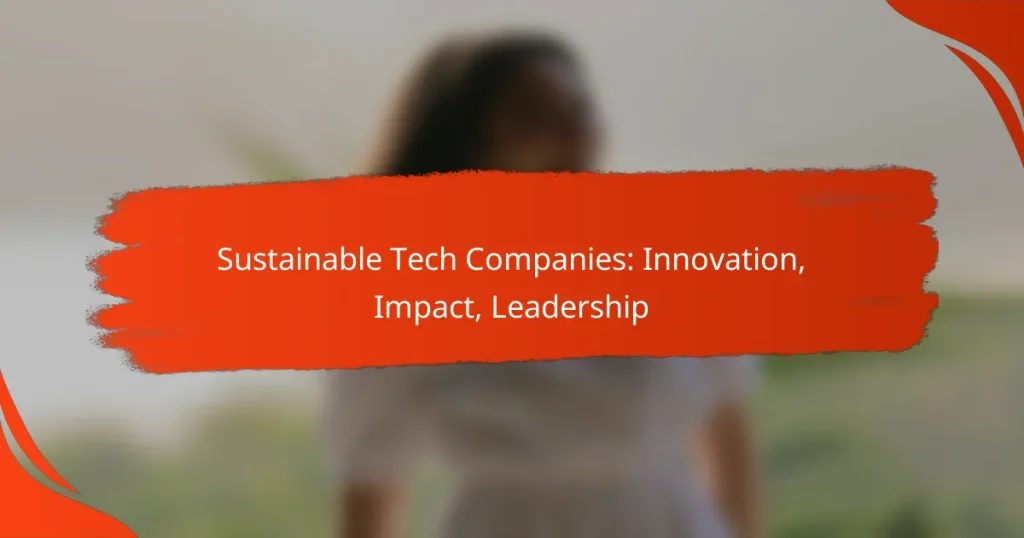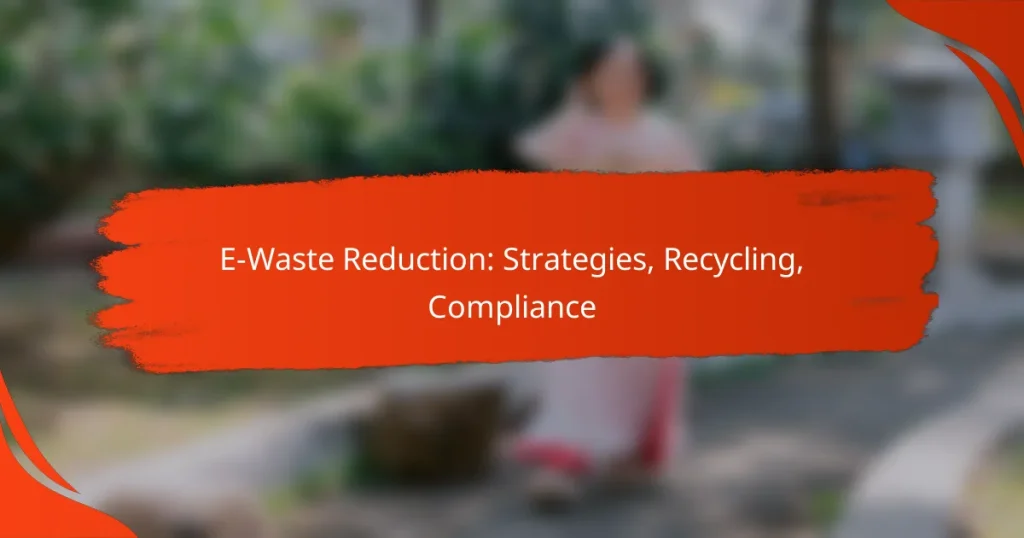Sustainable technology encompasses a range of innovations designed to minimize environmental impact while enhancing efficiency and cost-effectiveness for businesses. By adopting solutions such as solar energy systems and energy-efficient practices, organizations can significantly reduce their operational costs and contribute to a healthier planet. These technologies not only optimize resource use but also promote long-term sustainability and resilience in the face of climate change.
Smart Home Devices: Energy Savings, Automation, Compatibility
Green Apps: Tracking, Education, Community Engagement
Solar Panels: Efficiency, Cost, Installation, Warranty
Eco-Friendly Gadgets: Functionality, Design, Sustainability
E-Waste Reduction: Strategies, Recycling, Compliance
What are the best sustainable technologies for businesses?
The best sustainable technologies for businesses include solar energy systems, energy-efficient lighting, smart building technologies, waste management solutions, and green transportation options. These technologies not only reduce environmental impact but can also lead to significant cost savings and improved operational efficiency.
Solar energy systems
Solar energy systems harness sunlight to generate electricity or heat, making them a popular choice for businesses aiming to reduce their carbon footprint. Installing solar panels can lead to substantial savings on energy bills, especially in sunny regions. Businesses should consider factors such as installation costs, available incentives, and the potential for energy storage solutions.
In many areas, government incentives can offset initial costs, making solar a more attractive investment. Businesses may also explore options like power purchase agreements (PPAs) to finance solar installations without upfront costs.
Energy-efficient lighting
Energy-efficient lighting, such as LED bulbs, consumes significantly less energy than traditional incandescent or fluorescent lights. Transitioning to LED lighting can reduce energy costs by up to 75%, depending on usage. Businesses should assess their current lighting systems and consider retrofitting or replacing outdated fixtures.
Additionally, implementing smart lighting controls, such as motion sensors and timers, can further enhance energy savings by ensuring lights are only on when needed.
Smart building technologies
Smart building technologies integrate various systems to optimize energy use, enhance comfort, and improve operational efficiency. These technologies include automated heating, ventilation, and air conditioning (HVAC) systems, as well as smart meters that monitor energy consumption in real-time. Businesses should evaluate their building management systems to identify opportunities for upgrades.
Investing in smart technologies can lead to improved employee productivity and satisfaction, as well as reduced energy costs. It’s essential to consider compatibility with existing systems and potential return on investment when implementing these solutions.
Waste management solutions
Effective waste management solutions help businesses minimize waste generation and improve recycling rates. Implementing a comprehensive waste audit can identify areas for improvement and guide the development of a waste reduction strategy. Businesses should consider options like composting, recycling programs, and partnerships with waste management companies.
Educating employees about waste reduction practices is crucial for success. Setting measurable goals and tracking progress can help maintain focus and drive continuous improvement in waste management efforts.
Green transportation options
Green transportation options, such as electric vehicles (EVs) and public transit incentives, can significantly reduce a business’s carbon emissions. Transitioning to an electric fleet can lower fuel costs and maintenance expenses over time. Businesses should evaluate the feasibility of EVs based on their operational needs and available charging infrastructure.
Encouraging employees to use public transportation or carpooling can also contribute to sustainability goals. Offering incentives for green commuting options can enhance employee engagement and support a company’s commitment to environmental responsibility.
How can sustainable technology reduce costs?
Sustainable technology can significantly lower expenses by optimizing resource use and minimizing waste. By implementing energy-efficient systems and eco-friendly practices, businesses can achieve substantial savings in operational costs.
Lower energy bills
Utilizing sustainable technology often leads to lower energy consumption, which directly translates to reduced energy bills. For instance, switching to LED lighting or energy-efficient appliances can cut electricity costs by 20-50% over time.
Investing in renewable energy sources, such as solar panels, can further decrease reliance on traditional energy providers, leading to long-term savings. Many companies report a return on investment within a few years due to these energy savings.
Reduced waste disposal fees
Implementing sustainable practices can lower waste disposal fees by minimizing the amount of waste generated. Companies that adopt recycling programs or composting initiatives often see a reduction in waste management costs.
For example, businesses that reduce packaging waste or utilize biodegradable materials can save on disposal fees, which can range from hundreds to thousands of dollars annually, depending on the volume of waste produced.
Tax incentives for green initiatives
Many governments offer tax incentives for businesses that invest in sustainable technology. These incentives can include tax credits, deductions, or grants aimed at promoting green initiatives.
In the United States, for instance, businesses can benefit from the Investment Tax Credit (ITC) for solar energy systems, which can cover a significant percentage of installation costs. Understanding local regulations and available incentives can enhance financial savings while promoting sustainability.
What are the environmental benefits of sustainable technology?
Sustainable technology offers significant environmental benefits by reducing negative impacts on ecosystems and promoting resource efficiency. By integrating eco-friendly practices and innovations, it helps mitigate climate change, conserve resources, and improve overall environmental health.
Reduced carbon footprint
One of the primary advantages of sustainable technology is its ability to lower carbon emissions. This can be achieved through renewable energy sources, such as solar and wind, which replace fossil fuels in energy production. For instance, transitioning to solar panels can reduce a household’s carbon footprint by a substantial margin, often by several tons annually.
Additionally, energy-efficient appliances and smart home technologies can further decrease energy consumption, contributing to a smaller carbon footprint. Implementing these technologies not only benefits the environment but can also lead to significant savings on energy bills.
Conservation of natural resources
Sustainable technology plays a crucial role in conserving natural resources by promoting recycling, reusing materials, and utilizing renewable resources. For example, biodegradable materials and sustainable farming practices can help preserve water and soil quality, ensuring these resources remain available for future generations.
Moreover, companies adopting circular economy principles focus on minimizing waste through innovative product designs that allow for easier recycling and repurposing. This approach not only conserves resources but also reduces the demand for new raw materials, which can be environmentally damaging to extract.
Improved air and water quality
Implementing sustainable technologies can lead to significant improvements in air and water quality. For instance, electric vehicles produce zero tailpipe emissions, which helps reduce air pollution in urban areas. Transitioning to cleaner energy sources can also decrease harmful pollutants released into the atmosphere.
In terms of water quality, sustainable practices such as rainwater harvesting and greywater recycling can minimize water waste and reduce the burden on local water supplies. These technologies help maintain cleaner waterways and promote healthier ecosystems, benefiting both wildlife and human populations.
What criteria should businesses consider when selecting sustainable technology?
Businesses should evaluate cost-effectiveness, scalability, and regulatory compliance when selecting sustainable technology. These criteria help ensure that the technology not only meets environmental goals but also aligns with financial and operational objectives.
Cost-effectiveness
Cost-effectiveness is crucial for businesses aiming to adopt sustainable technology. This involves analyzing both initial investment and long-term savings, including energy efficiency and maintenance costs. For example, solar panels may have a high upfront cost but can significantly reduce electricity bills over time.
When assessing cost-effectiveness, consider the total cost of ownership (TCO), which includes installation, operation, and disposal costs. Businesses should also look for technologies that offer incentives or rebates, which can offset initial expenses.
Scalability
Scalability refers to the ability of sustainable technology to grow with the business. A scalable solution can adapt to increasing demands without requiring a complete overhaul. For instance, cloud-based energy management systems can be expanded as a company grows, allowing for more data and control without significant additional investment.
When selecting scalable technology, evaluate how easily it integrates with existing systems and whether it can accommodate future upgrades. This foresight can prevent costly disruptions and ensure long-term viability.
Regulatory compliance
Regulatory compliance is essential for businesses to avoid legal penalties and maintain a positive reputation. Companies should be aware of local and international regulations regarding sustainability, such as emissions standards or waste management laws. Compliance not only protects the business but can also enhance its marketability.
To ensure compliance, businesses should stay informed about relevant regulations and consider technologies that are designed to meet or exceed these standards. Regular audits and assessments can also help identify areas for improvement and ensure ongoing adherence to regulations.
How does sustainable technology impact consumer behavior?
Sustainable technology significantly influences consumer behavior by encouraging eco-conscious choices and fostering a preference for brands that prioritize sustainability. As consumers become more aware of environmental issues, their purchasing habits shift towards products and services that align with their values.
Increased brand loyalty
Consumers are increasingly loyal to brands that demonstrate a commitment to sustainability. When companies adopt eco-friendly practices, they build trust and emotional connections with their customers, leading to repeat purchases. Brands that effectively communicate their sustainability efforts often see higher retention rates.
For instance, companies like Patagonia have cultivated a strong following by promoting their environmental initiatives, which resonate with their target audience. This loyalty can translate into long-term profitability and a competitive edge in the market.
Preference for eco-friendly products
There is a growing preference among consumers for eco-friendly products, driven by increased awareness of environmental issues. Many shoppers actively seek out items made from sustainable materials or those that minimize carbon footprints. This trend is evident in various sectors, from fashion to electronics.
For example, consumers may choose biodegradable packaging over traditional plastic or opt for energy-efficient appliances. Brands that offer clear information about the sustainability of their products often attract environmentally conscious buyers.
Influence on purchasing decisions
Sustainable technology plays a crucial role in shaping purchasing decisions, as consumers weigh the environmental impact of their choices. Factors such as product lifecycle, energy consumption, and recyclability are becoming essential considerations in the buying process.
To capitalize on this trend, businesses should highlight the sustainability features of their products. Providing transparent information and certifications, such as Energy Star or Fair Trade, can help consumers make informed decisions that align with their values.




